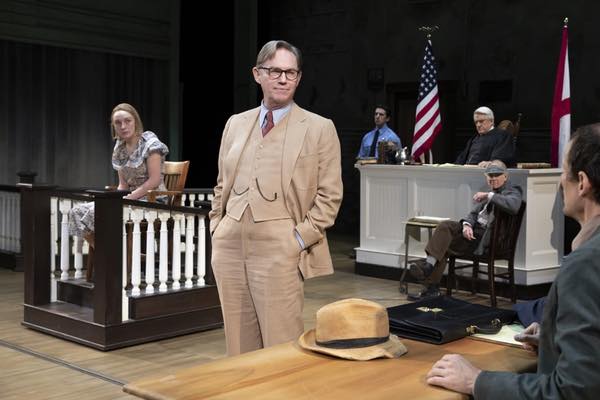
The mockingbird is noted for its ability to duplicate the sounds it hears. The bird’s reference in the title of Harper Lee’s epic novel, To Kill a Mockingbird, supposedly refers to the statements of prejudice that are repeated over and over in the book’s famous trial: statements about Blacks, Jews, the more and less educated, the economic class of a person. The only way to stop the sounds is to destroy the source. A play version of the book is now on stage at the Connor Palace in Playhouse Square.
The script of the play did not have an easy trip to the Great White Way. Christopher Sergel did a staged adaptation of the novel that has been licensed for over 50 years and has been performed by numerous educational institutions and community theaters. When Scott Rudin decided to do an adaptation by Aaron Sorkin, “his lawyers claimed worldwide exclusivity for the professional stage rights to any adaptation of Lee’s novel and shut productions of the Sergel adaption staged within 25 miles of any city that might eventually host a production of Sorkin’s adaptation.”
The outcry was great as dozens of theaters across the U.S. were required to cancel productions of Sergel’s adaptation. After a public outcry, Scott Rudin offered to “ameliorate the hurt” by making Sorkin’s adaptation available to regional producers.
That was only part of the script’s issues before its opening. “During development of the play, the Lee estate alleged that Sorkin had made too many changes to the original story by framing Atticus as the main character instead of Scout.” After a suit and a countersuit, the premiere of the show was confirmed after an agreement was reached between the two parties.
Was all the hullaballoo worth it? From both the critical and audience sense the answer is a definite, “Yes.” The Broadway show opened to mostly positive reviews, and the show has been sold out from its opening, to the pandemic shutdown, and since the re-up of theater in the Big Apple.
For those who haven’t read the book (And why, may I ask, have you not probed one of the great American classics?), To Kill a Mockingbird is a dark drama, with humorous interludes, about the roots and consequences of racism and prejudice. It probes how good and evil can coexist within a single community and within individuals.
The plot and characters are loosely based on Lee’s observations of her family, her neighbors and an event that occurred near her hometown of Monroeville, Alabama, in 1936, when she was ten. In the Sorkin-written play there is less emphasis on the coming of age as the children look back at the story as grownups, not as children, suppressing some of the innocence perspective. The focus has been shifted onto Atticus Finch and the societal issues.
The story covers a span of three years. Scout Finch lives with her brother Jem and their father Atticus in the fictitious town of Maycomb, Alabama, a small, close-knit tradition-bound town, where every family has its social station depending on where they live, who their parents are, their educational level, occupation, and how long their ancestors have lived in Maycomb.
Scout and Jem discover that their father is going to represent Tom, a black man who is accused of beating and raping a white woman. Tom is tried and convicted even though Atticus proves that he could not have possibly committed the crime. In the process of presenting Tom’s case, Atticus inadvertently insults Bob Ewell, a nasty, lazy drunkard whose daughter is Tom’s accuser. Ewell vows revenge on Atticus and the judge for besmirching his already tarnished name.
Things slowly return to normal in Maycomb, but one night when Scout and her brother are returning from a school event, they are assaulted. Their attacker, Bob Ewell, is killed by a mysterious savior. Scout realizes that the protector is reclusive neighbor Boo Radley. The sheriff refuses to press charges against Boo as he saved the children and no good would come from another stress-inducing trial. The town will never again be the same, but life will go on.
The touring production, under the direction of Bartlett Sher, is finely honed. Melanie Moore is totally believable as Scout, texturing the character with the right levels of empathy and curiosity. Justin Mark, as Scout’s brother Jem, and Steven Lee Johnson as Dill, the visiting neighbor, also bring the right level of youthful curiosity and believability to their roles.
Richard Thomas, yes, John Boy from the iconic TV show, The Waltons, brings his own slant to the role of Atticus. This is not a Gregory Peck, who played Atticus in the movie, imitation. He is less a perfect man and more a real human, with flaws. Well done!
Joey Collins was properly obnoxious as the vile Bob Ewell. He was so realistic that he received boos in the curtain call from the opening night audience, who had trouble separating the actor from his role. That is a high tribute to any actor.
Arianna Gayle Stucki was appropriately pathetic as Ewell’s daughter Mayella. Yaegel T. Welch portrayed Tom with great sensitivity and Jacqueline Williams had the right level of compassion and indignation as Calpurnia, the Finch’s housekeeper.
Capsule judgment: The touring production, under the direction of Bartlett Sher, is finely honed. The staging, casting and technical aspects of the play are impeccable. This is theater at its finest. It is an absolutely must-see for anyone interested in a well-written, meaningful story that is as relevant today as when it was written.
To Kill a Mockingbird runs through Sun 5/15 at the Connor Palace Theatre as part of the Key Bank Broadway Series. For tickets go to playhousesquare.org or call 216-241-6000.
Written by Roy Berko, member: Cleveland Critics Circle and American Theatre Critics Association]